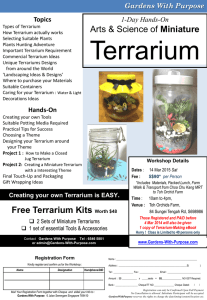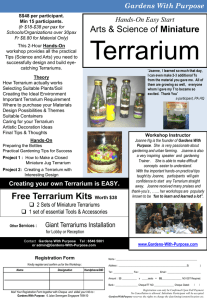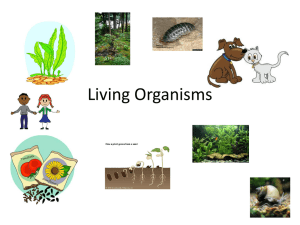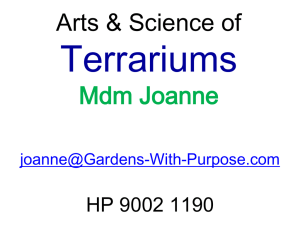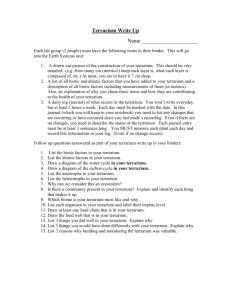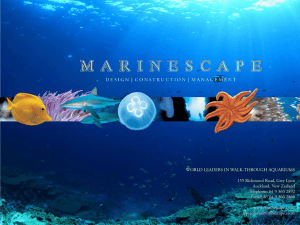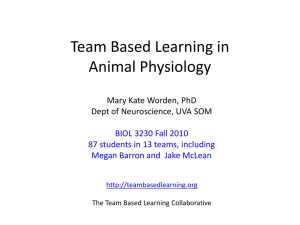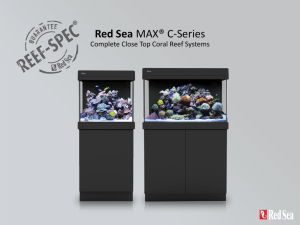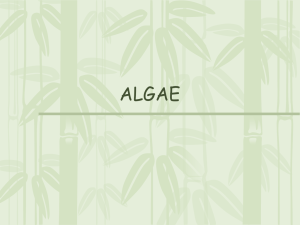Ecosystems PPT
advertisement
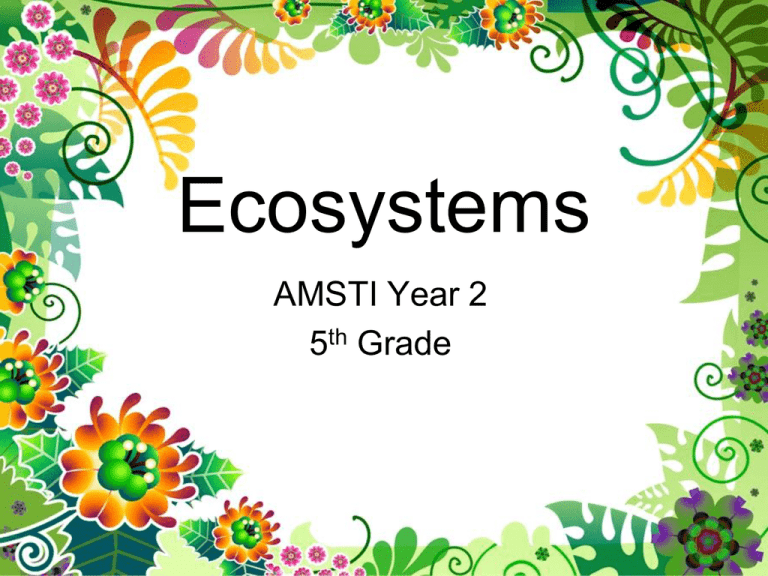
Ecosystems AMSTI Year 2 5th Grade AL COS Alignment • #3 Use everyday indicators to identify acids and bases (Lesson 8) • #8 Identify major body systems and their functions (Lessons 4,6) • #9 Describe the relationship of populations within a habitat (Lessons 1-6) • #9a Food chains and webs (Lessons 1-16) • #9b Symbiotic relationships (Lesson 7) Lesson 1 Thinking About Ecosystems • QUESTION: What is an ecosystem? • PREDICT: An ecosystem is . . . • PLAN/MATERIALS: 1. Make a KWL of “How living things depend on each other”. 2. Make an illustration of a perfect ecosystem. 3. Discuss as a group the riverbank environment Thinking About Ecosystems • DATA: What we know now: (skip three lines) What we would like to find out: (skip three lines) • WHAT I LEARNED: • NEW QUESTION: Thinking About Ecosystems • Next Steps/New Questions (Answer one of the following) *Describe a situation in nature in which one living thing depends on another living thing. *Look at the riverbank environment again. Imagine that a group of people begins to set up a city in this area. What will change? * What problems might occur when humans interfere with an environment? Lesson 2 Setting up the Terrarium • QUESTION: What is a terrarium? • PREDICTION: A terrarium is a . . . • PLAN/MATERIALS: 1. Review pgs. 11-12 of student investigation book. 2. Explain distribution center and how to pick up supplies. 3. Record data on table as you build your terrarium. • DATA: Setting up the Terrarium Material Soil Alfalfa Seed Grass/Rye Seed Mustard Seed Rock/Twig/ Leaves Water Amount/Size Color/Description Other Observations Setting up the Terrarium • WHAT I LEARNED: • NEW QUESTION: Lesson 3 Setting up the Aquarium • QUESTION: What is an aquarium? • PREDICTION: An aquarium is . . . • PLAN/MATERIALS: 1. Review pg. 16 of student investigation book. 2. Explain distribution center and how to pick up supplies. 3. Record data on table as you build your aquarium. Setting up the Aquarium • DATA: Material Gravel Water Elodea Duckweed Algae Amount/Size Color/ Description Other Observations Setting up the Aquarium • WHAT I LEARNED: • NEW QUESTION: Lesson 3--Reading Duckweed, Elodea, and Algae • QUESTION: Why are duckweed, elodea, and algae important to the life of an ecosystem? • PREDICTION: Duckweed, elodea, and algae are needed because. . . • PLAN/MATERIALS: 1. Read as a group pgs. 17 – 20. 2. List 3 reasons for each; duckweed, elodea, & algae Duckweed, Elodea, & Algae • DATA: Duckweed – Elodea – Algae – • WHAT I LEARNED: • NEW QUESTION: Duckweed, Elodea, & Algae • REFLECTION: Explain three ideas about what you have read. Lesson 4 Adding Animals to the Aquarium • QUESTION: What is the relationship between the plants and animals in the aquarium? • PREDICTION: Plants and animals in the aquarium . . . • PLAN/MATERIALS: 1. Review pg. 24-25 of student investigation book. 2. Explain distribution center and how to pick up supplies. 3. Record data on table as you add your animals to your aquarium. Adding Animals to the Aquarium • DATA: Snails Size Number Color Motion Shape Other Observations Guppies Adding Animals to the Aquarium • WHAT I LEARNED: • NEW QUESTION: Lesson 4--Reading Guppies & Snails • QUESTION: How does each animal contribute to the environment? • PREDICTION: Guppies contribute. . . Snails contribute. . . • PLAN/MATERIALS: 1. Read as a group pages 26-28. 2. List three facts about each animal. Guppies & Snails • DATA: Guppies – Snails – • WHAT I LEARNED: • NEW QUESTION: Lesson 5--Observing the Completed Aquarium • QUESTION: What changes might occur in aquarium and terrarium? • PREDICTION: Changes in the aquarium and terrarium include. . • PLAN/MATERIALS: 1. Observe the aquarium and terrarium. 2. Make and discuss a living and non-living web. Observing a Completed Aquarium • DATA: • Record Sheet 4A Insert completed web • WHAT I LEARNED: • NEW QUESTION: Lesson 6 Adding Animals to the Terrarium • QUESTION: Why do we wait until now to add the animals to the terrarium? What are producers? • PREDICTION: We waited because. . . • PLAN/MATERIALS: 1. Materials manager brings terrarium to the back table. 2. Insert animals and return to the group. 3. Make observations. Adding Animals to the Terrarium • DATA: Draw and label the parts of one isopod and cricket. Record Sheet 6A • WHAT I LEARNED: • NEW QUESTION: Lesson 6--Reading Isopods and Crickets • QUESTION: How are the crickets and isopods alike? How are they different? • PREDICTION: Crickets and isopods are alike. . .different.. • PLAN/MATERIALS: 1. Read as a group pages 38-40. 2. List three facts about each animal. Isopods and Crickets • DATA: • WHAT I LEARNED: • NEW QUESTION: Lesson 7--Joining the Terrarium and Aquarium • QUESTION: What is the relationship between the terrarium and the aquarium? • PREDICTION: The terrarium and the aquarium . . . • PLAN/MATERIALS: 1. Follow directions on page 44 of the Student Investigations book. 2. Discuss the Food Chain Wheel. 3. Make a Terrarium Web (living & nonliving) Joining the Terrarium and Aquarium • DATA: Web and Food Chain Wheel • WHAT I LEARNED: • NEW QUESTION: Lesson 8 Upsetting the Stability • QUESTION: How will a pollutant affect our ecosystem? • PREDICTION: Pollutants affect our ecosystem by. . . • PLAN/MATERIALS: 1. Discuss natural pollutants. 2. Discuss human pollutants. 3. Decide which pollutants will be used. Reading Selections • Read the passage assigned to your group on pp.48-52 • Use library and web resources to gather additional information about your pollutant. • Be prepared to share your information with the class in Lesson 9. • Predict what would happen if your pollutant was added to one of the class ecocolumns. Upsetting the Stability • WHAT I LEARNED: • NEW QUESTION: • REFLECTION: Lesson 9 Reporting on Pollutants • Following the guidelines we discussed in Lesson 8, present your information to the class on the assigned pollutant. • During other presentations, be a good listener. Take notes and write down any questions you want to ask the groups. Ecocolumn Observation • Draw and label the components of your ecocolumn. • Record any changes that have taken place since you joined the aquarium and terrarium. • Give one example of interdependence found in your ecocolumn. Lesson 10 Planning Pollution Experiments • How can we test the effects of the three pollutants using our class ecocolumns? • What factors (variables) will we have to keep the same to have a fair test? Pollutant Fact Sheets • Use the pollutant fact sheet to help design your experiment. • You may test all three pollutants in your class or only one. • Don’t forget to leave one ecocolumn as your control for comparison. Record Sheet 10A • The pollutant we are testing is _____. • We will make it by mixing ______ with ______ water. • We will add _______ dropperfuls to our experimental ecocolumn _____ times per week. Record Sheet 10A • Our question we will try to answer is : • To make our experiment a fair test, we will not change these factors: Record Sheet 10A • In our daily observations, we will look for these conditions: • We predict that our ecocolumn will show these changes to the plants and algae after adding the pollutant: Record Sheet 11A Terrarium Date of Observation Pollutant Used Amount of Pollutant pH Description of Plants Number of Plants Description of Algae Other Observations Aquarium Record Sheet 13-A • Use your observations, drawings, and data tables to complete Sheet 13-A. • Give specific answers and use supporting details from your science notebook. • Given the results of the pollution experiment, why do you think we continue to use road salt, fertilizers, and fossil fuels? Pollutant Experiment Results • DATA: 2 days Vinegar Road Salt Fertilizer 4 days 8 days 16 days What We Found Out About The Effects of Acid Rain • Terrarium: • Aquarium: • What would happen to the animals? What We Found Out About The Effects of Overfertilization • Terrarium: • Aquarium: • What would happen to the animals? What We Found Out About The Effects of Road Salt • Terrarium: • Aquarium: • What would happen to the animals? The Chesapeake Bay: An Ecosystem in Danger • What are the main problems in the Chesapeake Bay? • How are these problems similar to what you experienced with the pollution experiment? • Describe a situation where too much of something is going into the bay. • Describe a situation where too much of something is being taken out of the bay. • Describe another ecosystem that is similar to the Chesapeake Bay. Lesson 15-16 Examining a Real Environmental Problem • Students will represent a particular point of view in a “mini-conference” regarding the Chesapeake Bay issue • Citizen • Dairy Farmer • Waterman • Land Developer • Recreational Boater Lesson 15-16 Examining a Real Environmental Problem • Use pp.149-160 to help students understand the point of view of their assigned group • In a class presentation, each group must answer the following: What do you see as the problem in the Chesapeake Bay? What are your proposed solutions? What are the advantages to your solution? What are the disadvantages? Lesson 15-16 Examining a Real Environmental Problem • Use Record Sheet 15-A to help students organize their presentation • Introduce the term trade-off • Establish guidelines for the miniconference so that groups remain focused and respectful of others’ ideas • Once all groups have spoken, have the class choose which group has the best solution and discuss the reasons behind their choice
